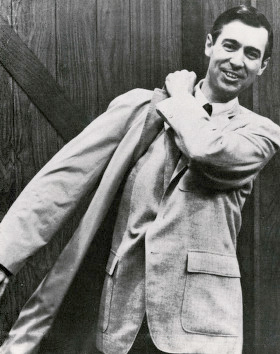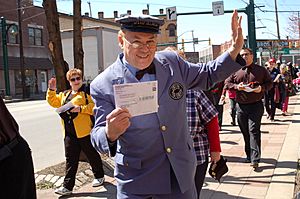Mister Rogers' Neighborhood facts for kids
Quick facts for kids Mister Rogers' Neighborhood |
|
|---|---|
 |
|
| Genre |
|
| Created by | Fred Rogers |
| Starring |
|
| Theme music composer | Fred Rogers |
| Opening theme | "Won't You Be My Neighbor?" |
| Ending theme |
|
| Composer(s) |
|
| Country of origin | United States |
| Original language(s) | English; some episodes feature DVS via SAP |
| No. of seasons | 31 |
| No. of episodes | 912 (including specials) |
| Production | |
| Production location(s) | WQED Studios Pittsburgh, Pennsylvania |
| Camera setup | Single camera (1968–1992), Multi-camera (1992–2001) |
| Running time | 28 minutes |
| Production company(s) |
|
| Distributor | American Public Television |
| Release | |
| Original network | |
| Picture format | 480i SDTV |
| Audio format | Mono (1968–1989) Stereo (1989–2001) |
| Original release | February 19, 1968 – August 31, 2001 |
| Chronology | |
| Followed by | Daniel Tiger's Neighborhood |
Mister Rogers' Neighborhood was a popular American TV show for kids. It was created and hosted by Fred Rogers. The show taught important lessons and helped children understand their feelings.
The show first aired in Canada in 1962 under the name Misterogers. Fred Rogers then brought the show to the United States in 1966. It became Mister Rogers' Neighborhood and started airing across the country on February 19, 1968. It was shown on PBS until August 31, 2001.
Mister Rogers' Neighborhood was made for young children (ages 2 to 5). However, PBS said it was "appropriate for all ages." The show was produced in Pittsburgh, Pennsylvania. It was one of the longest-running children's TV shows ever. Reruns were shown until 2008.
Years after the show ended, an animated spin-off called Daniel Tiger's Neighborhood began. In 2018, a special tribute show called Mister Rogers: It's You I Like aired. It was hosted by actor Michael Keaton, who got his start on Mister Rogers' Neighborhood.
The Story of Mister Rogers' Neighborhood
The idea for the show began in 1953. Fred Rogers worked at a new public TV station called WQED. He helped create a show called The Children's Corner. On this show, Fred Rogers used puppets and wrote music. Many of the puppet characters and songs from Mister Rogers' Neighborhood were first developed here. This is also when Fred Rogers started wearing his famous sneakers. He found them quieter than his regular shoes when he moved around behind the set.
From Canada to the U.S.
In 1961, Fred Rogers moved to Toronto, Canada. He worked on a new show for CBC Television called Misterogers. This show was 15 minutes long. For Misterogers, Fred Rogers appeared on camera himself, not just through puppets. Many of the famous set pieces, like the trolley and the castle, were made for this Canadian show.
In 1966, Fred Rogers brought his show back to WQED in Pittsburgh. He renamed it Misterogers' Neighborhood. At first, it was shown only in the northeastern United States. The show was canceled in 1967 because of money problems. But many people wanted it back, so new funding was found.
In 1967, the Sears Roebuck Foundation helped fund the show. This allowed it to be shown all over the country. The first national episode aired on February 19, 1968. When PBS took over from NET in 1970, they continued to air the show. Around this time, the name changed slightly to the more familiar Mister Rogers' Neighborhood.
The show aired until 2001. The studio where it was filmed in Pittsburgh was later named "The Fred Rogers Studio."
How the Show Worked
In each half-hour episode, Fred Rogers talked directly to the viewers. He would discuss different topics, show how things were made, or demonstrate crafts and music. He always acted naturally on camera. He believed that children could tell if someone was pretending.
A special part of the show was the puppet segment in the Neighborhood of Make-Believe. Fred Rogers would also visit different places in his "real" neighborhood. He would interview people about their jobs, like the baker at Brockett's Bakery or the musician at Negri's Music Shop.
Starting and Ending the Show
Each episode began with a slow camera pan over a model of the neighborhood. The "Neighborhood Trolley" would cross the streets. Then, Fred Rogers would come home, singing "Won't You Be My Neighbor?". He would change from his jacket and dress shoes into a comfortable sweater and sneakers. One of his famous sweaters is now in the Smithsonian Institution!
At the end of each show, Fred Rogers would sing "It's Such a Good Feeling." He would change back into his jacket and dress shoes. Before saying goodbye, he would remind viewers: "You always make each day a special day. You know how: By just your being you/yourself. There's only one person in the whole world that's like you, and that's you. And people can like you just/exactly the way you are. I'll be back next time. Bye-bye!".
From 1979 onwards, episodes were grouped into week-long series. Each week focused on a specific topic. Fred Rogers would explore different parts of the topic. The stories in the Neighborhood of Make-Believe would also help explain the theme.
Important Topics
Fred Rogers talked about many different subjects over the years. He wasn't afraid to discuss difficult topics that other children's shows avoided. For example, in 1970, he talked about the death of a pet goldfish. The show also discussed feelings like anger, competition, and even divorce. Fred Rogers always focused on peaceful ways to deal with strong emotions.
He always made it clear that his TV neighborhood was real, but the Neighborhood of Make-Believe was pretend. He would often say, "Let's pretend that..." before showing the puppet segments. The miniature motorized trolley was the only thing that appeared in both the real world and Make-Believe. It would transport viewers between the two places.
The trolley was almost like a character itself. It would often "talk" to King Friday XIII by moving and making bell noises. The trolley also showed the difference between the worlds when it became a school bus for the younger puppet characters. In Mister Rogers' house, it had paper cutouts of a bus stuck to its sides. But in the Neighborhood of Make-Believe, it looked like a real school bus.
The show also featured "Picture Picture," a special projector. In early episodes, it would magically show films or slides. Later, Fred Rogers would manually insert the films. When not in use, Picture Picture would display a painting or simply say "Hello" or "Hi."
The music on the show was unique. It was often inspired by jazz and played live during filming. Fred Rogers wrote over 200 original songs for the show.
Meet the Characters
Mister Rogers' Neighborhood featured many friendly characters. Some were real people, and others were puppets.
Characters from Mister Rogers' Neighborhood
These characters appeared in the "real" world parts of the show:
- Neighbor Aber (Chuck Aber) - He did many jobs in Westwood.
- Lady Aberlin (Betty Aberlin) - King Friday XIII's niece. She also managed Betty's Little Theater.
- Chef Brockett (Don Brockett) - The owner of Brockett's Bakery.
- Officer Clemmons (François Clemmons) - A police officer who was also an opera singer.
- Mr. McFeely (David Newell) - The "Speedy Delivery" man. He was a frequent visitor to Mr. Rogers' house. He was named after Fred Rogers' grandfather.
- Mrs. McFeely (Betsy Nadas) - Mr. McFeely's wife.
- Handyman Negri (Joe Negri) - A jazz guitarist who owned Negri's Music Shop.
- Miss Paulificate (Audrey Roth) - The royal telephone operator.
- Bob Trow - He ran Trow's Workshop, where he made and fixed things.
Only a few characters, like Mr. McFeely and Chef Brockett, appeared in both the real world and the Neighborhood of Make-Believe.
Characters from the Neighborhood of Make-Believe
The "Neighborhood of Make-Believe" was a fictional kingdom. Its characters were played by both hand puppets and actors. Fred Rogers was the puppeteer for many of them:
- Collette
- Cornflake S. Pecially
- Daniel Stripèd Tiger
- Donkey Hodie
- Edgar Cooke
- Grandpère Tiger
- Henrietta Pussycat
- Ino A. Horse
- King Friday XIII
- Lady Elaine Fairchilde
- Mrs. Frogg
- Princess Margeret H. Lizard
- Queen Sara Saturday
- Tadpole Frogg
- X the Owl
Other characters were played by different puppeteers or actors:
- Anna Platypus
- Betty Okonak Templeton-Jones
- Bob Dog
- Cousin Mary Owl
- Cousin Steven Owl
- Dr. Duckbill Platypus
- Elsie Jean Platypus
- Harriett Elizabeth Cow
- H.J. Elephant III
- Hula Mouse
- James Michael Jones
- Prince Tuesday
- Purple Panda
- Robert Troll
Michael Keaton had his first TV role on the show in 1975. He played an acrobat and was in charge of running the Trolley.
Operas in Make-Believe
The show featured 13 special "operas" within the Make-Believe segments. These operas would take up an entire episode. Many of them featured opera singer John Reardon.
- Babysitter Opera (1968)
- Campsite Opera (1968)
- Teddy Bear/Whaling Ship Opera (1969)
- "Pineapples and Tomatoes" (1970)
- "Monkey's Uncle" (1971)
- "Snow People and Warm Pussycat" (1972)
- "Potato Bugs and Cows" (1973)
- "All in the Laundry" (1974)
- "Key to Otherland" (1975)
- "Windstorm in Bubbleland" (1980)
- "Spoon Mountain" (1982)
- "A Granddad for Daniel" (1984)
- "A Star for Kitty" (1986)
A play called Josephine The Short-Necked Giraffe also aired in 1989.
Special Guests on the Show
Many famous people visited Mister Rogers' Neighborhood. These included cellist Yo-Yo Ma and actor Lou Ferrigno (who played The Incredible Hulk). Guests were often surprised that Fred Rogers was just as kind in real life as on TV. He was also a perfectionist who believed children deserved the best quality programming.
Fred Rogers also appeared as a guest on other TV shows. He was on the animated series Arthur, where he played himself as an aardvark. Later, Arthur appeared as a puppet on Mister Rogers' Neighborhood. Fred Rogers also exchanged visits with Bill Nye (the Science Guy) and Captain Kangaroo. He even appeared on Sesame Street to explain to Big Bird that it's okay to lose a race.
See also
 In Spanish: Mister Rogers' Neighborhood para niños
In Spanish: Mister Rogers' Neighborhood para niños



